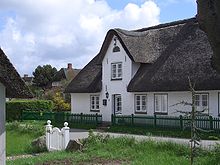Uthland Frisian house
The Uthland Frisian house (colloquially also known as the Friesenhaus ), a special form of the Geesthardenhaus , is a type of house that has existed for centuries in the North Frisian Uthlanden , i.e. H. on the islands , Halligen and in the marshes of the area, was predominant.
Construction
The houses have the peculiarities of all Friesland houses: the - often whitewashed - brickwork is made of red brick, and they have a thatched roof and window frames and doors painted white, blue or green. The buildings, reminiscent of the early medieval longhouses , were originally relatively small and provided with an inner wooden frame. Should the massive coastal storms severely damage the roof and walls, the internal structure continued to offer the residents a certain protection. In the Uthland houses, the stable and living space were housed within one building.
The buildings are built along an east-west axis in order to offer the least possible surface for the wind, which usually comes from the west. The entrances to the stable and living rooms are in the south, sheltered from the wind. Since the house is limited in size due to its construction, there are often other adjacent stable buildings. What is striking is that all the buildings in such an ensemble have their entrances on the same side. This is particularly noticeable on the Halligen. Since livestock farming and seafaring were the main occupations in the areas concerned, large storerooms were not necessary for the harvest, so that the Uthland-Frisian houses offer no space for this apart from the attic.
In contrast to the Geestharden houses on the mainland, the so-called Uthland Frisian houses have a pointed gable above the entrance door, which extends to just below the ridge. The Frisian houses on the mainland have a wider, less pointed gable (back gable). These gables (wide or pointed) were created so that in the event of a fire the burning thatch on the roof does not slide in front of the entrance door, but instead falls down to the right and left of it, guided by the gable. The escape route thus always remains free.
The statics of these houses is based on a stud frame, which means that the load of the roof and the hayloft rests on wooden studs that lie within the non-load-bearing outer walls. The outer walls are only used for weather protection and could therefore be designed to be relatively weak from a static point of view. Since islands and Halligen were largely treeless, people often used flotsam such as powered ship masts and planks for the wooden posts.
The foundations of the houses, which usually do not have a basement, are made of field stones . In some houses there is a non-accessible storage room under the kitchen, which is lined with field stones and set into the floor and served as a cooling and storage room.
Another feature of the Uthland Frisian houses is the Klöntür . This door is horizontally divided in two so that the upper half can be opened alone, for example to ventilate. The closed lower half prevented that small animals, which were often kept around the house, could get into the room. The half-open door was an excellent way to chat with the neighbors. Schwatzen = Sylt Frisian "Klöön" (Low German "Klönen"); hence the name of this type of door.
Well-preserved and typical Uthland houses can be found, for example, on the Hallig Langeneß with the houses Tadsen (built in 1741) and Sönnichsen (today the hostel of the local history museum), on Sylt with the Old Frisian House and on Amrum with the Öömrang Hüs . Haus Olesen , built in 1617 and now in Wyk auf Föhr after being demolished and rebuilt , is the oldest preserved house of this type and is now also part of a local museum.
literature
- Ellen Bauer, Ludwig Fischer, Hans Joachim Kühn, Matthias Maluck, Dirk Meier: The Schleswig-Holstein Wadden Sea Region . Lancewad Report 2001 of the Wadden Sea Secretariat. Digitized version (PDF; 229 kB)

